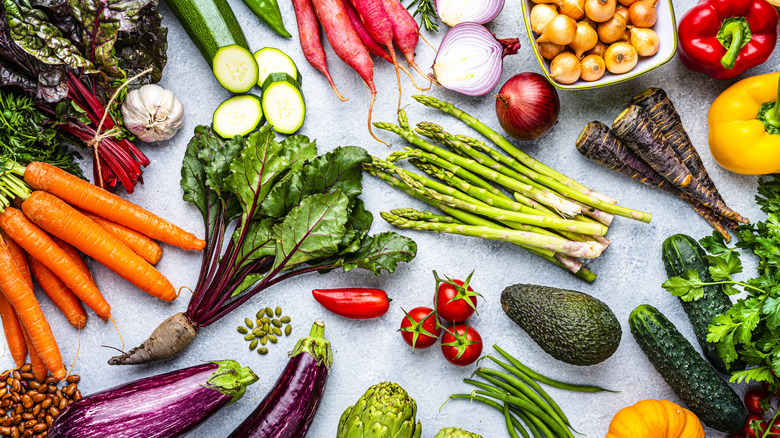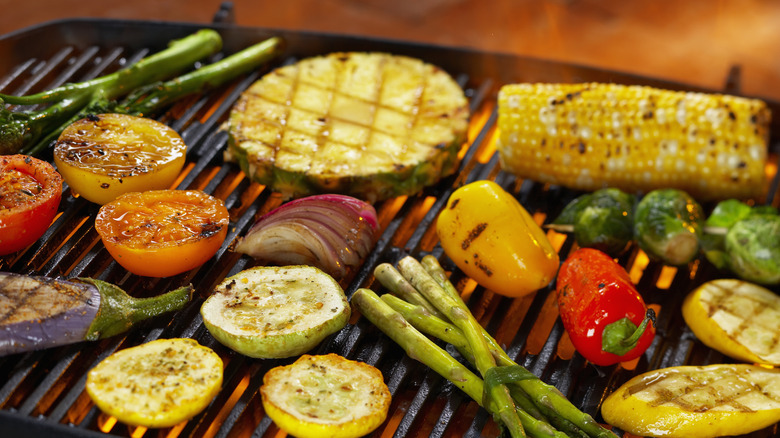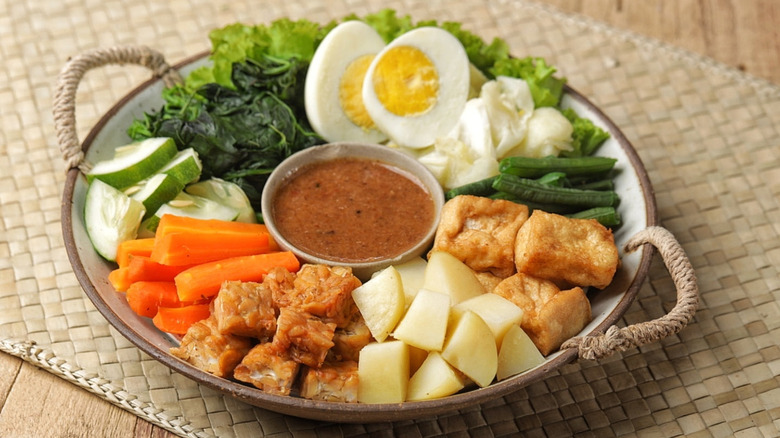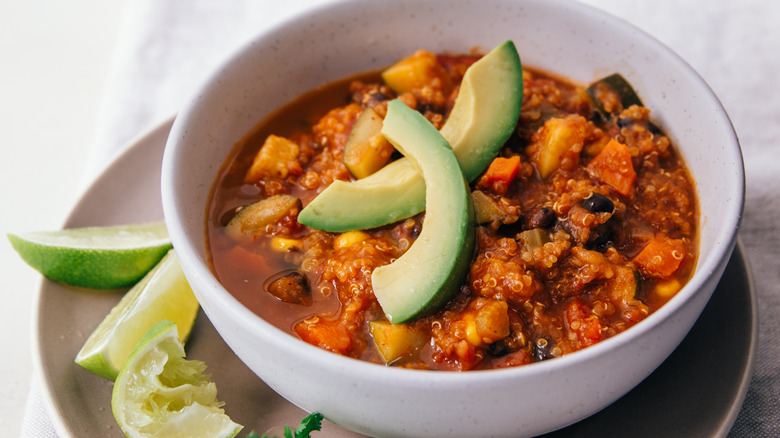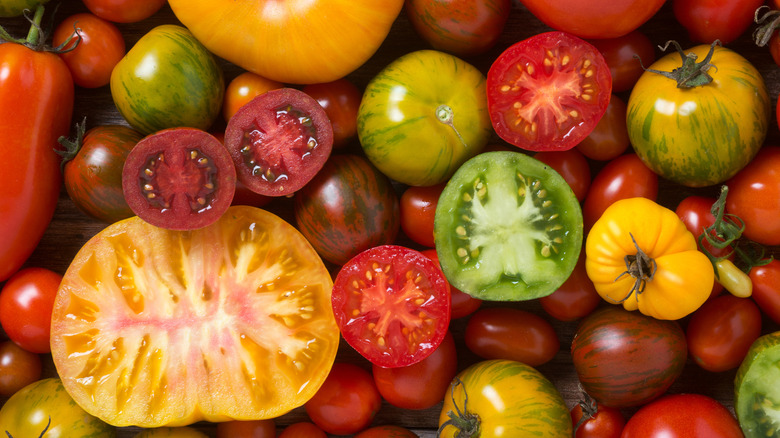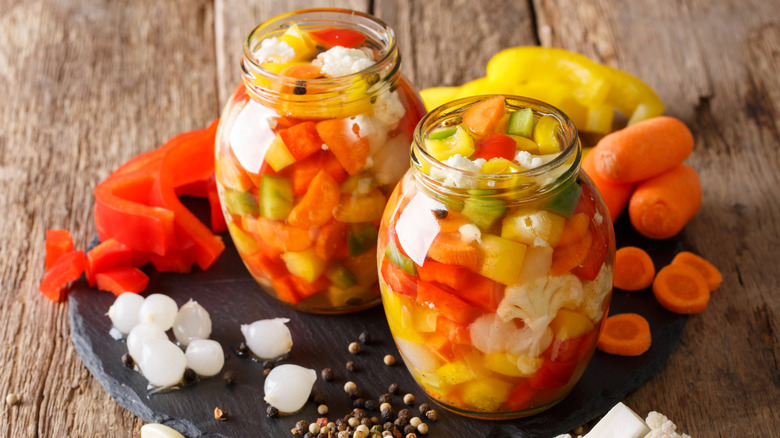The Best Tricks For Making Vegetable Dishes More Exciting
We are constantly being urged to eat more vegetables, whether by dietitians concerned with our health or environmentalists worried about the planet. Some people may enjoy vegetables no matter how they're presented, but others feel that they need a little help in order to actually be tasty. To get a few tips on making vegetables more palatable, The Takeout turned to plant-based food blogger Jem Mantiri of The Fruity Jem. They had quite a few ideas about how to make vegetables more flavorful that range from cooking methods to seasoning to incorporating them in other dishes.
For a balanced perspective, though, we also included a little input from someone who's an admitted vegetable hater (that would be me). Although I don't have Mantiri's advantage of enjoying most vegetables, I've accepted that as an actual grown-up, I do have to force myself to eat a few now and then, and it helps if I can find ways to make them more appealing. While I've been known to sneak them into other foods so I can eat more veggies without tasting them, I'm also learning to appreciate them in different ways.
Cook vegetables with dry heat
Jem Mantiri pointed out that when it comes to most vegetables, the cooking method matters. "Roasting and grilling are two of my favorite ways to enhance the texture and flavors of vegetables," they told us, explaining, "They allow caramelization to occur, therefore adding complexity and depth to the vegetables." In their opinion, just about any vegetable can be enhanced by roasting or grilling. As roasting takes place in an oven (it's pretty much the same thing as baking, only at temperatures of 400 degrees Fahrenheit and above), this means that the miniature convection oven you call an air fryer can also be used to cook vegetables and improve the flavor.
The cooking methods you need to watch out for with vegetables tend to be the ones that involve moist heat. While boiled or microwave-steamed corn can be a wonderful thing, this doesn't hold true for all types of produce. In Mantiri's opinion, "Boiling and steaming tend to leave most veggies bland unless they are served with a separate sauce."
Try different seasonings and sauces
Jem Mantiri advocates experimenting with different seasonings for vegetables; the bolder, the better. "Most people are afraid of adding too many spices," they told us, but went on to say, "Spices really boost the flavor of vegetables and are key in vegetarian and vegan cooking." If you stick to nothing more than salt and pepper, your vegetables will likely be less than amazing. "In general," said Mantiri, "I would encourage people to start putting a bit more seasoning on their vegetables." Among the spices and seasonings that Mantiri recommended adding to vegetables are garlic, miso paste, mushroom powder, smoked paprika, soy sauce, and tomato paste. You can also opt for Indian-style spices like garam masala, since a lot of Indian cuisine is vegetarian.
For inspiration, Mantiri advised taking a look at dishes like Indonesian gado-gado – a salad made with veggies like cabbage, lettuce, beans, potatoes, and cucumbers. It is served alongside peanut sauce flavored with punchy ingredients such as fresh chiles, shallots, and tamarind. Chinese mapo tofu is another example, as it is seasoned with ingredients like tingly Sichuan peppercorns and fermented bean paste. While it typically includes ground meat, Mantiri said this ingredient can easily be swapped out for a plant-based substitute.
Add extra ingredients
If you're thinking of moving toward a more plant-based lifestyle, either on a full-time basis or simply by adopting meat-free Mondays, Jem Mantiri said, "The key here is to stop thinking that vegetables are just side dishes." Clearly, you can't get by on vegetables alone, since while they may have all kinds of nutrients, they typically fall short on protein. Mantiri noted that the addition of legumes like beans and lentils can turn other vegetables into a satisfying meal, as can soy-based meat substitutes such as tofu or tempeh. They also suggested adding rice, bread, grains, or another carbohydrate, pointing out, "In general, vegetable dishes do contain fewer calories than meat-based dishes, which is also why you might need to eat more for a fuller vegetarian or vegan meal."
Even with added protein and starch, you may need a little something extra to transform your vegetable-based entree. According to Mantiri, "Sauces and dressings are also important and should not be left out, as they can make or break dishes." If you do take some time and effort to balance the flavors and season everything just right, though, a meat-free meal can be quite memorable. As Mantiri put it, "When they are given the same attention that people often give to meat, vegetables can truly shine."
In-season vegetables may taste better
Jem Mantiri suggested using vegetables that are in season when possible, pointing out, "Seasonal vegetables are harvested at their peak ripeness, meaning they're naturally sweeter and more flavorful." On the other hand, they said, "Out-of-season produce is often picked early and lacks the same depth of flavor. These off-season produce often also have to travel long distances, which can affect their taste and texture."
Does this mean you need to restrict yourself to only eating tomatoes and corn in the summertime? No, but instead of eating not-so-fresh vegetables from the supermarket produce section in winter, it might be time to shop the frozen and canned food aisles instead. Frozen vegetables are just as healthy as fresh ones, and depending on how you prepare them, they can be equally tasty. As for canned vegetables, some kinds are better than others. Canned peas and asparagus may be somewhat of a disappointment, but you should always have canned beans in your pantry, and even professional chefs use canned tomatoes.
Pickle your veggies
My vegetable-hating identity was forged at a time when vegetables were often overcooked. The only vegetables I actually tolerated, apart from corn on the cob and french fries (since who doesn't like those?), were the pickled peppers and eggplants my dad used to make, as well as anything and everything in bottled giardiniera. I'm talking about Italian-style giardiniera, which is simply pickled vegetables as opposed to the oil-based sandwich condiment popular in Chicago. To this day, I refuse to consume cauliflower in the form of faux Buffalo wings, pizza crust, or other impostors, much less as its unadulterated self, but I can't get enough of it in a vinegary giardiniera mix.
If you're unexcited by boiled cabbage, you can swap it out for sauerkraut or kimchi — the latter dish is also endorsed by Jem Mantiri as being "really flavorful." Bored by plain cucumbers? Chomp on a gherkin or try our half-sour cucumber salad. Pickled vegetables offer that tangy taste I love, along with the crunch that's the antithesis of being boiled to oblivion. For these reasons, they're probably my favorite way to turn a once-loathed food into something much more enjoyable.
